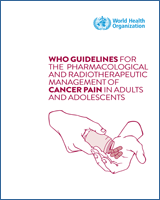Full methods of the guideline development process, including the systematic review methods, are provided in Annex 2.
In summary, the GDG met on 28–29 July 2016 to outline the scope of the guideline questions and then met again on 20–21 November 2017 to deliberate and determine the recommendations made in response to 13 key clinical questions. The questions included issues such as the optimal choice of medicines for initiating and maintaining cancer pain relief, management of breakthrough pain, use of adjuvant medicines including steroids, anticonvulsants and anti-epileptics for cancer pain relief and optimal management of bone pain. See Annex 4 for the full details of the clinical questions.
Systematic reviews were completed for each question by independent review teams in advance of the meeting and shared with the GDG prior to the meeting. This included a network meta-analysis (NMA) comparing different groups and classes of analgesic medicines for managing cancer pain.
Outcomes were rated by GDG members, according to the importance of each outcome from the perspective of the person living with cancer pain, as “not important” (1–3), “important” (4–6) or “critical” (7–9). Outcomes rated as critical were included in final GRADE (Grading of Recommendations Assessment, Development and Evaluation) evidence profile tables which were presented to the GDG for determining the balance between benefits and potential harms. The steps undertaken for the retrieval of evidence, assessment and synthesis are summarized in Annex 2.
For making recommendations on interventions, GRADE methodology as defined in the WHO Handbook for guideline development was used to provide a rating of the overall quality of evidence arising from each systematic review (categorized as very low, low, moderate or high).
Values and preferences of the intervention were considered from the perspectives of patients. These perspectives were discussed by the GDG members, all of whom had broad professional experience of the field.
When considering the use of resources, the GDG was presented with the pricing of drugs where this was available and brought their knowledge of medication prices from around the world to the considerations. No formal cost-effectiveness studies were conducted, but the GDG considered the longer-term benefits of each recommendation in terms of possible reductions in hospitalization and morbidity.
The GDG proffered observations and their own experiences regarding the acceptability of interventions to health-care workers and the feasibility of implementation of recommended interventions, especially in regions were resources are scarce or absent. Similarly, the effect of provision of an intervention on equity was carefully considered through discussion within the GDG. No formal surveys of patients or health-care providers were conducted.
Based on the agreed quality of the evidence and with consideration given to the values and preferences of patients, the acceptability and feasibility of the intervention within the health-care system, the potential impact on equity and the resource implications, the GDG decided on the direction of the recommendation (either in favour or against an intervention) and whether to make strong or conditional recommendations using a benefit–risk assessment of each intervention. In the absence of any evidence on a particular review question, the GDG chose to make no recommendation.
For several questions where evidence was scant or lacking, the GDG recognized that established practices exist but did not formulate recommendations for or against the practices. For two such questions, best practice statements were formulated instead in view of the potential benefit and lack of any observed harms from current practices. For those questions where harms or lack of effect were less certain, specifically in patients with cancer pain, the GDG advocated that clinicians conduct an individual trial of therapy in their patients and assess the response accordingly. Ideally, and wherever possible, clinicians are encouraged to enrol eligible patients into a clinical trial to establish efficacy and build the evidence base.
Conflicts of interest were managed by requesting all GDG members to complete a WHO Conflicts of Interest (COI) form in advance of the meeting and to declare these before the entire GDG. Relevant declared interests of GDG members are reported in Annex 4. None of the declared interests were considered by WHO to be conflictual. WHO policies on COI were fully applied throughout.

